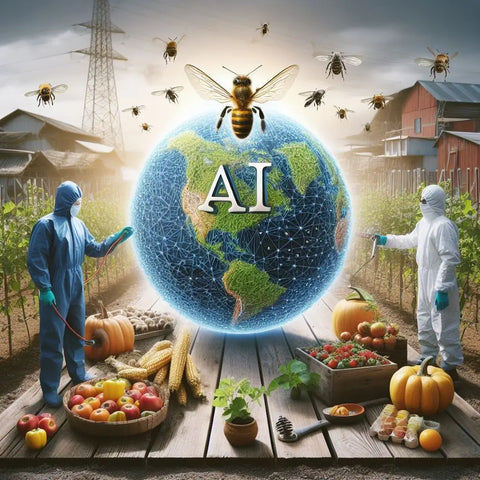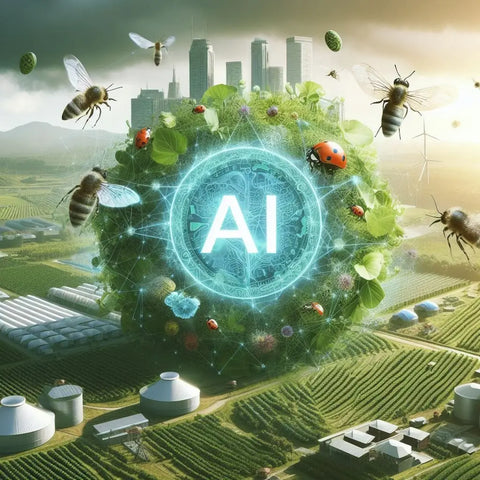Sustainable Pest Control in Modern Agriculture
Power of AI for Sustainable Pest Control in Permaculture
Pest Control
In an era of persistent improvements in modern agriculture, the quest to attain sustainable and environmentally friendly solutions is of top priority. With the world`s population still expanding, the need for food production had just become so much bigger, even creating immense pressure on the old farming techniques. The complexity of dealing with pests is not new.

The permaculture principle is an imitation of the natural process, which is based on the synthesis of natural patterns and relations. It is leading to stable ecosystems that do not require the destructive use of chemicals or intervention. Presently, pest control, a chronic problem found in any setting of agricultural production, is a tricky job of farming traditionally and the use of modern technologies in equal measure.
AI-enabled pest control becomes an integral aspect
The advent of these cutting-edge solutions draws upon the functionality of machine learning, computer vision, and predictive analytics to curb pest outbreaks with powerful precision and effectiveness.
A remarkable virtue of artificial technology-enhanced pest control in permaculture is that it permits us to detect and specify pests at the very onset of their lives everywhere. Such systems integrate high-tech sensors and algorithms that detect the presence of any kind of pest—insects, rodents, or others—shortly, which prevents the further spread of the problem merely with a timely and selective reaction.
Additionally, AI-imbued systems are programmed to sift through large volumes of data points that range from the history of pests’ infestations to environmental parameters to anticipate and prevent pest breaches. We can lead the way in this intelligence-based approach to pest management by instantly implementing preventative measures and eventually finding out the less resource-intensive methods of reactive pest control.
Precision in Action:
Pests may cause significant difficulties in practicing agriculture due to their pestilent behavior.
The fundamentals of these AI-enabled pest control products are to use very advanced algorithms and sensor networks that are interconnected and associated with the machinery to create a real-time, comprehensive perspective of the whole environment. This can be done by integrating IoT devices, drones, and state-of-the-art imaging technologies, which have the unique ability to capture the ecological dynamics of plant, insect, and other organism populations with high precision.
Pest management can be individualized by drones piloted by computers that have the function of deep learning and a vision for technology. The modern actors of this eco-technology—the high-tech aerial sentinels—can review very large platoons of permaculture plots, and these sentinels can detect specific pest hotspots and help to apply specific remedies, such as the release of beneficial insects or the exact application of natural pest deterrents.
Furthermore, AI-aided pest management solutions can fit the status quo of a respective permaculture site and overcome problems suitable for the specific site. Soils are first analyzed for their soil composition, microclimatic conditions, and species of pests that have especially affected the growing area. This data leads to recommendations about the types of strategies that are most suitable to more effectively protect the ecosystem and minimize the need for synthetic pesticides or other disruptive interventions.
Empowering Permaculture Practitioners
A more practical view would be that the connection between human-taught pest management systems and permaculture systems goes beyond the use of devices. They also give the practitioners of permaculture deep knowledge about their area of specialization, equipping them with information that is more than enough for better decision-making.
With the help of AI-powered systems that can process abundant data about the life cycles of organisms, patterns of following seasonal changes, and the efficiency of already-applied pest control methods, permaculture fans can humbly collect invaluable information that can improve their solutions. Such a framework provides for designing, promoting, and maintaining sustainability, which could have the other consequences of enhancing biodiversity, circulating nutrients, and making the system stronger.
Not only this, but there has been a surge in AI-oriented solutions that are becoming increasingly accessible, allowing these solutions to be viable and increasing the chances of applying them to small-scale permaculture ventures and urban farming initiatives. With time, as the process develops, entrants into the permaculture field who leverage artificial intelligence in pest control are faced with reduced barriers of entry, thus democratizing access to transformational technology.
Integrating green technologies into pest control minimizes the adversities on our environment and ensures a safe and sustainable future.
While concerns about foods for an increasing population and the delicate balance between our ecosystems are a conundrum, the introduction of AI-powered pest management, associated with permaculture, could be instrumental in containing the spread of pandemics. Permaculture allows humans to integrate the potential of artificial intelligence and achieve a level of precision and efficiency in pest control that was not possible before. This allows it to move on towards a type of world where ecological balance is a common life picture.

However, as technology keeps on progressing and merging more and more with nature, the dawn of an era when AI, along with permaculture methods, will play essential roles in the agricultural industry may come sooner than expected. But adherents to this new view can become crucial to the development of a food-secure, ecologically sensitive, and technology-enabled tomorrow where all those enjoy it as well.
FAQs
What data is collected and analyzed by AI-powered pest management systems, and from what sources does the AI system acquire the data?
AI-powered pest management solutions in permaculture rely on the collection and analysis of a wide range of data, including AI-powered pest management solutions in permaculture rely on the collection and analysis of a wide range of data, including:
- Real-time data from the sensors of IoT devices that measure beyond just factors like temperature, humidity, soil quality, and crop health.
- The imaging and video footage procured by drones, cameras, and other imaging sources will be useful for this purpose.
- Pest histories and environmental conditions are based on past insect trends or conditions.
- Detailed information on the exact pest species in the current location and the natural lifecycle pattern.
After running a huge quantity of data through the AI algorithms, the systems can distinguish features, foreshadow the appearance of pests, and give advice that is specific to each permaculture.
Which type of AI-powered pest management is appropriate for small-scale permaculture projects that need it, and how much does it cost?
The panel of AI-powered pest management solutions for small-scale permaculture projects is set for the day. This technology continues to become even more affordable and user-friendly as it keeps on growing. With this, many people can be trained in permaculture systems, making the learning experience a good one for more practitioners.





Leave a comment